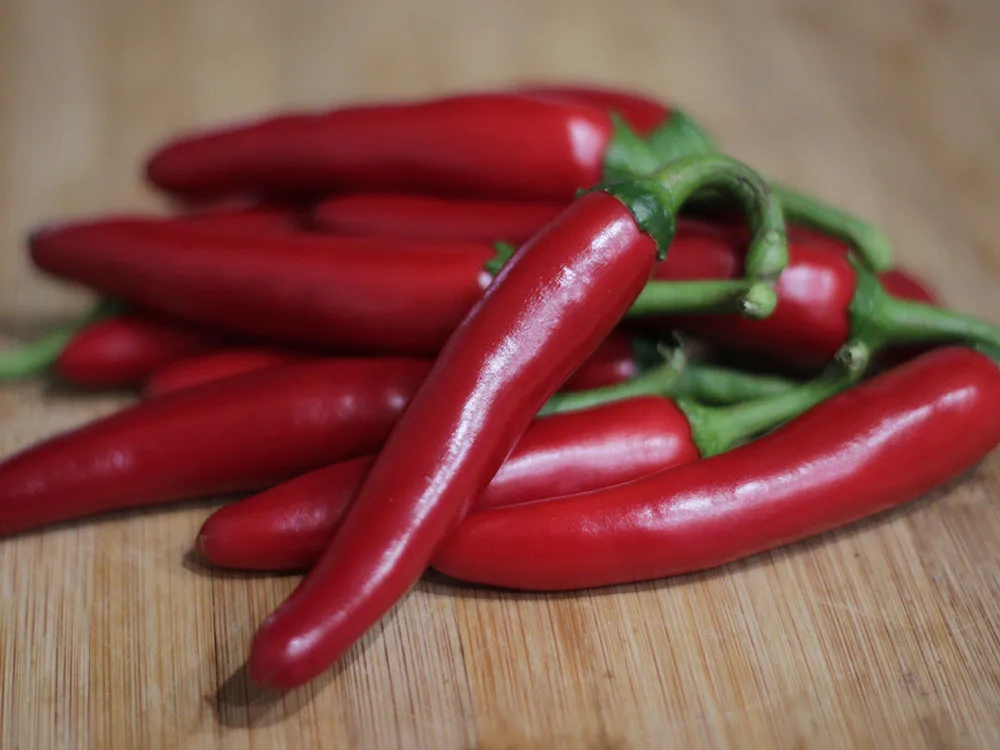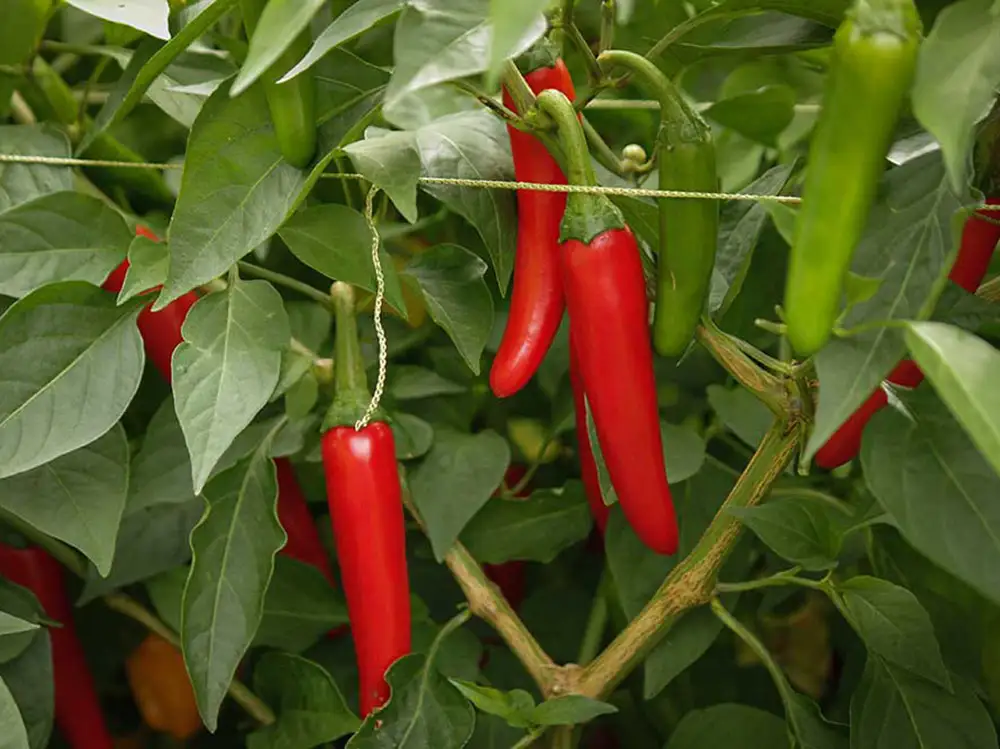Recipes
How To Make Korean Chili Pepper Flakes: Dehydrate or Sun-Dried
The word Gochugaru (or Gochu-garu) is often used interchangeably when referring to Korean chili pepper flakes. This is because the flakes are made from Gochugaru peppers which are dried and ground into coarse form, not powdered, with no seeds. Other common terms for these chili flakes are Gochugaru pepper flakes, Korean chili flakes, Korean hot pepper flakes, and Korean chili powder.
Taeyangcho vs. Gochugaru
The term Taeyangcho is often used when referring to the Gochugaru chili flakes. However, there is a difference. Derived from the word “Taeyang (태양)” means “sun” in Korean, taeyangcho is defined as sundried red peppers.
So essentially the flakes come from the same pepper, the difference being the way they are dried.

The sundried variety is said to have a better flavor and generally costs more at the market. Sun dried peppers also maintain their red color better than those dried in an oven or dehydrator creating more visual appeal.
Make Korean Chili Pepper Flakes

If you don’t have a Korean market or other source of for the peppers, you’ll need to grow your own Gochugaru seeds. More on this further down the page.
Preparing the Peppers
Start by cutting off the stem end then cut the peppers in half lengthwise. Next, remove the seeds, they’re easy to scrape out with a spoon. Don’t forget to save some seeds to grow next year.
For a consistent drying time, you should cut the peppers into evenly sized pieces as much as possible.
At this point you have two options for drying.
Dehydrator Method
If you plan on using a dehydrator, we recommend using a low temperature to preserve as much color as possible. You can start by dehydrating at 110F but keep in mind that these are thick-walled peppers and it will take a long time to fully dry at this temperature.
If you’re pressed for time and are not concerned about maintaining color then you can set the dehydrator at 135F. See our full article on how to dehydrate hot peppers.
- EVEN HEAT DISTRIBUTION: 600 watts of drying power provides even heat distribution; consistent drying that is four times faster than other food dehydrators
Sun Dried Peppers
If you’d prefer to try the Taeyangcho method of sun drying the peppers you can start preparing the peppers the same way mentioned above.
However, since the sun drying process will take longer, we recommend cutting the peppers into much smaller pieces to expedite the drying process. When air drying there is always a concern for molding.
Ensure the peppers dry as quickly as possible be sure. Smaller pieces will dry faster. You’ll also need some sort of screen or wire rack to suspend the peppers so air can reach all sides of the pepper pieces. The openings of the screen you use will dictate how small you can cut up the peppers.
Lay the screens out in the sun and check them periodically. The time it takes to sun dry peppers can vary depending on various factors such as the weather conditions, size of the peppers, and the desired moisture content.
On average, it can take anywhere from a few days to a couple of weeks for peppers to fully dry under the sun.
Are The Peppers Dry?
No matter the drying method used, the peppers should snap when bent if they are dry enough to make into flakes. If they bend or feel flexible at all let them dry longer.
Final Process
Now that the chili pepper pieces are fully dry it’s time to make your very own Korean chili pepper flakes. We start by crushing the peppers up with gloved hands. The peppers are thick walled, so you’ll likely only be able to get them to a very coarse state by hand.
Placing the course pepper flakes into blender or food processor will get them to a finer consistency. Place only a small amount at a time in the blender. Then just use the pulse feature until the pepper flake get to the desired consistency.
Uses For Korean Chili Pepper Flakes
The pepper flakes are very versatile and used in many Korean recipes. Although the flakes are most commonly used with Napa cabbage to make Kimchi (Tongbaechu-kimchi 통배추김치), you’ll find the flakes used in everything from soups and stews to Korean barbeque. They’re even great with fish, try them in this recipe for Spicy Cod Fillets (Daegusal-jorim 대구살조림). Below are a few more recipes you may enjoy using Korean chili pepper flakes.
- Kimchi pork ribs (Deungalbi-kimchijjim 등갈비김치찜)
- Spicy braised chicken breasts (Dakbokkeumtang 닭볶음탕)
- Spicy braised potatoes (Maeun-gamja-jorim 매운감자조림)
As you can see the Gochugaru chili pepper flakes are very versatile and can be used with most meats and vegetables. And why not use some of the pepper powder to make hot sauce?
The chili pepper flakes can also be used to make Gochujang as well, a hot pepper paste. We love Gochujang but it’s quite a process to do properly and takes a few months to ferment so we typically buy ours. If you’re having a hard time finding it locally you can purchase Gochujang on online.
Can I Grow Gochugaru Peppers?
Absolutely. However, Gochugaru peppers or plants are difficult to find at the market. As such you’ll need to start plants from seed if you’d like to grow your own. Gochugaru Korean pepper seeds can be purchased in our store. The Gochugaru pepper plants grow to a height of about 24-36″ tall and are very prolific.
You can easily grow Gochugaru peppers in a 5 gallon bucket or other container of the same capacity. They grow to about 36″ in height depending whether or not you pinch your pepper plants. The peppers average about 0.75″ in diameter and 4.5″ long, they are tubular with a blunt end. The peppers are thick walled resulting in a good amount of powder.
If you’re looking for an estimate, we typically get about 2 cups of Gochugaru flakes from each plant. Peppers are harvested once they reach a bright red color.
Conclusion
We hope you found this article useful. If you have any questions, be sure and post in the comment section below. If you’d like to grow peppers and make your own Korean chili pepper flakes you can purchase Gochugaru pepper seeds in our seed shop.
We sell many other varieties of pepper seeds as well, including other Asian peppers. If you’re pressed for time or not interested in growing peppers you can always just purchase Gochugaru pepper flakes.
FAQ: Korean Chili Pepper Flakes
Are Korean chili flakes the same as red pepper flakes?
Korean chili flakes, also known as gochugaru, are similar to red pepper flakes but have a distinct flavor and texture. Gochugaru is specifically made from sun-dried Korean red peppers and is coarser in texture compared to red pepper flakes.
What is the difference between gochujang and gochugaru?
Gochujang and gochugaru are both Korean chili products, but they serve different purposes. Gochujang is a fermented chili paste with a sweet and spicy flavor, while gochugaru refers to Korean chili flakes, which are used for seasoning and adding heat to various dishes.
What can I use instead of Korean chili flakes?
If you don’t have Korean chili flakes (gochugaru), you can substitute them with crushed red pepper flakes or cayenne pepper. Adjust the amount according to your preferred level of spiciness and flavor profile.
Are Korean red pepper flakes coarse or fine?
Korean red pepper flakes, also known as gochugaru, are typically coarse in texture. The flakes are larger compared to the finer texture of regular chili flakes, giving them a unique texture and allowing for a slower release of heat when used in cooking.
Is gochugaru spicier than cayenne?
Gochugaru and cayenne pepper have different levels of spiciness. Generally, gochugaru is considered milder than cayenne pepper. However, the spiciness can vary depending on the specific batch and individual preferences, so it’s always a good idea to adjust the amount based on your desired level of heat.












